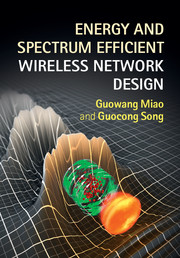Book contents
- Frontmatter
- Dedication
- Contents
- Preface
- Acronyms
- 1 Introduction
- Part I Basic concepts
- Part II Centralized cross-layer optimization
- Part III Distributed cross-layer optimization
- 12 Overview
- 13 Opportunistic random access: single-cell cellular networks
- 14 Opportunistic random access: any network topology
- 15 Optimal channel-aware distributed MAC
- 16 Opportunistic random access with intelligent interference avoidance
- 17 Distributed power control
- Part IV Cross-layer optimization for energy-efficient networks
- Appendix A Proofs of Theorems and Lemmas
- References
- Index
15 - Optimal channel-aware distributed MAC
from Part III - Distributed cross-layer optimization
Published online by Cambridge University Press: 05 December 2014
- Frontmatter
- Dedication
- Contents
- Preface
- Acronyms
- 1 Introduction
- Part I Basic concepts
- Part II Centralized cross-layer optimization
- Part III Distributed cross-layer optimization
- 12 Overview
- 13 Opportunistic random access: single-cell cellular networks
- 14 Opportunistic random access: any network topology
- 15 Optimal channel-aware distributed MAC
- 16 Opportunistic random access with intelligent interference avoidance
- 17 Distributed power control
- Part IV Cross-layer optimization for energy-efficient networks
- Appendix A Proofs of Theorems and Lemmas
- References
- Index
Summary
Decentralized optimization for multi-channel random access (DOMRA) is based on slotted Aloha and once a collision happens, the entire data frame has to be dropped. Although DOMRA is the optimal channel-aware Aloha, it is not the optimal channel-aware medium access control (MAC). The performance can be further improved through scheduling users in a distributed way to avoid the collision of data transmission. The goal of all distributed MAC design is to transmit as much as possible while avoiding as many collisions as possible. With awareness of channel state, an additional goal is to exploit multi-user diversity and enable users with better channel states to win the contention with higher probabilities and thus to maximize network performance, as has been illustrated in Section 12.2.
Network performance is upper bounded by that of central schedulers. One fundamental question is: “Can distributed random access algorithms achieve the performance of centralized algorithms, and how to do it?” This chapter will introduce a feasible solution to these questions. We want the solution to be applicable to as many types of wireless networks as possible, e.g. cellular networks, ad hoc networks, sensor networks, and so on. We consider a very generic network model, where the network can have arbitrary topologies. In addition, the spatial traffic distributions can also be arbitrary in the sense that users can receive traffic from or send traffic to different users, and different communication links may interfere with each other.
- Type
- Chapter
- Information
- Energy and Spectrum Efficient Wireless Network Design , pp. 182 - 202Publisher: Cambridge University PressPrint publication year: 2014

